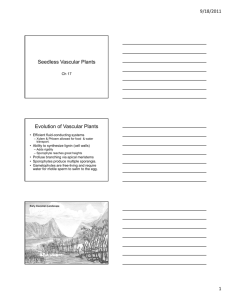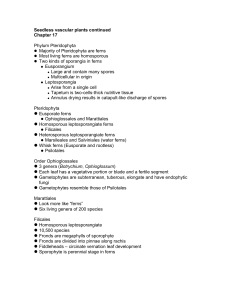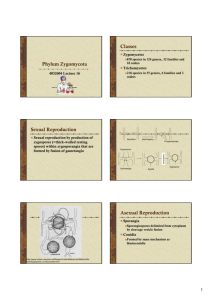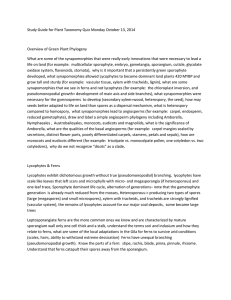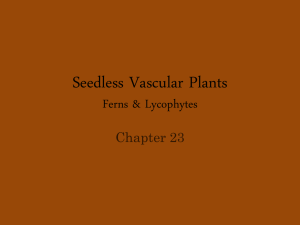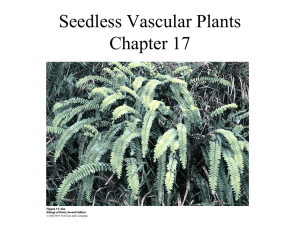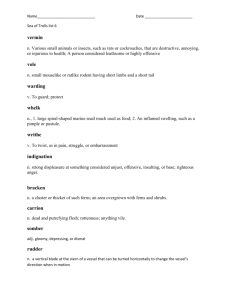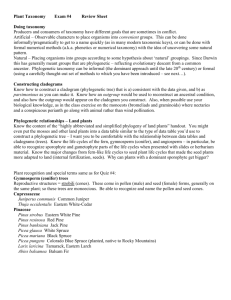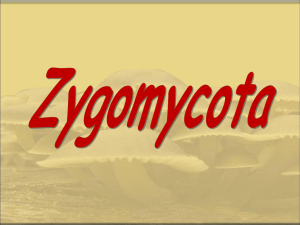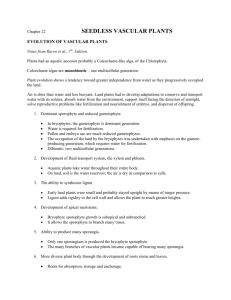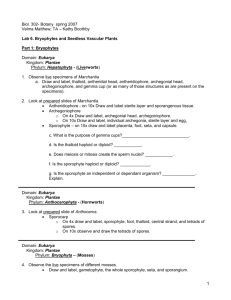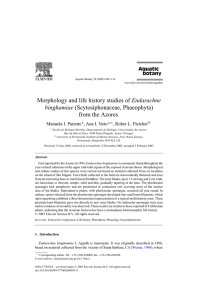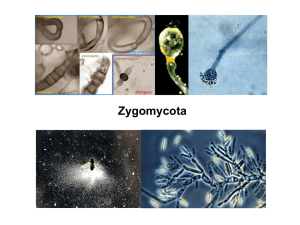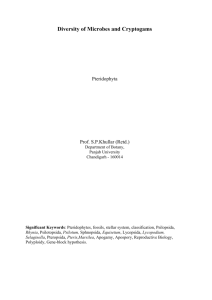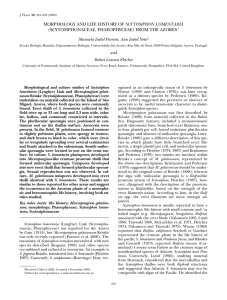Laboratory 3: Lycophytes and Eusporangiate Ferns
advertisement
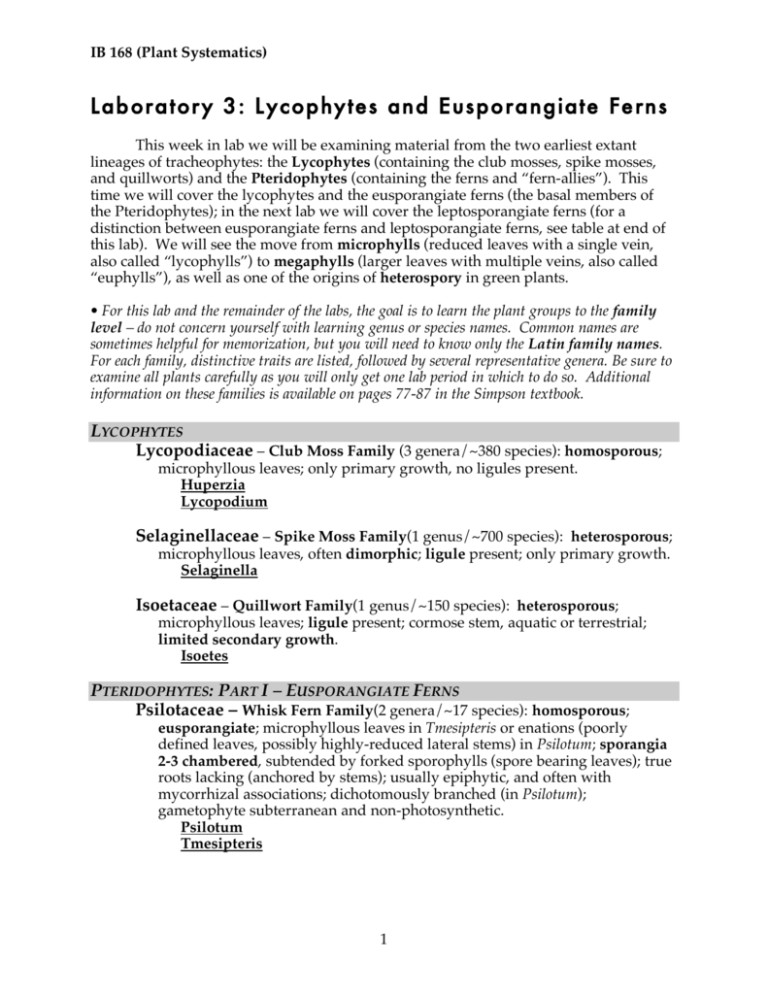
IB 168 (Plant Systematics) Lab ora tory 3: Lycop hytes and Euspora ng iate Fe rns This week in lab we will be examining material from the two earliest extant lineages of tracheophytes: the Lycophytes (containing the club mosses, spike mosses, and quillworts) and the Pteridophytes (containing the ferns and “fern-allies”). This time we will cover the lycophytes and the eusporangiate ferns (the basal members of the Pteridophytes); in the next lab we will cover the leptosporangiate ferns (for a distinction between eusporangiate ferns and leptosporangiate ferns, see table at end of this lab). We will see the move from microphylls (reduced leaves with a single vein, also called “lycophylls”) to megaphylls (larger leaves with multiple veins, also called “euphylls”), as well as one of the origins of heterospory in green plants. • For this lab and the remainder of the labs, the goal is to learn the plant groups to the family level – do not concern yourself with learning genus or species names. Common names are sometimes helpful for memorization, but you will need to know only the Latin family names. For each family, distinctive traits are listed, followed by several representative genera. Be sure to examine all plants carefully as you will only get one lab period in which to do so. Additional information on these families is available on pages 77-87 in the Simpson textbook. LYCOPHYTES Lycopodiaceae – Club Moss Family (3 genera/~380 species): homosporous; microphyllous leaves; only primary growth, no ligules present. Huperzia Lycopodium Selaginellaceae – Spike Moss Family(1 genus/~700 species): heterosporous; microphyllous leaves, often dimorphic; ligule present; only primary growth. Selaginella Isoetaceae – Quillwort Family(1 genus/~150 species): heterosporous; microphyllous leaves; ligule present; cormose stem, aquatic or terrestrial; limited secondary growth. Isoetes PTERIDOPHYTES: PART I – EUSPORANGIATE FERNS Psilotaceae – Whisk Fern Family(2 genera/~17 species): homosporous; eusporangiate; microphyllous leaves in Tmesipteris or enations (poorly defined leaves, possibly highly-reduced lateral stems) in Psilotum; sporangia 2-3 chambered, subtended by forked sporophylls (spore bearing leaves); true roots lacking (anchored by stems); usually epiphytic, and often with mycorrhizal associations; dichotomously branched (in Psilotum); gametophyte subterranean and non-photosynthetic. Psilotum Tmesipteris 1 IB 168 (Plant Systematics) Ophioglossaceae – Adder’s-tongue Family(3 genera/~80 species): homosporous; eusporangiate; true roots present, but lacking root hairs; gametophytes bisexual and non-photosynthetic; fertile fronds divided into fertile and sterile segments; stipe fleshy, sori embedded in tissue of the fertile spike; terrestrial or epiphytic, often with mycorrhizal associations. Ophioglossum Botrychium Equisetaceae – Horsetail Family(1 genus/~15 species): homosporous (some extinct forms possibly heterosporous); leaves reduced and scale-like in a whorl at each node; stems jointed; mostly primary growth (secondary growth in some); sporangia produced on sporangiophores organized into a terminal strobilus, sometimes on separate, unbranched stems. Equisetum Marattiaceae (4 genera/~600 species): – Homosporous; eusporangiate with sporangia united into synangia or ± free in Angiopteris; fleshy stipules present; rachis often with swollen nodes (pulvini); fronds can reach up to 8 m in length. Marattia Angiopteris Danaea Christensenia Eusporangia Leptosporangia Arise from several initial cells Arise from a single initial cell Sporangium wall more than one cell layer thick Sporangium wall composed of only a single layer of cells Produce many spores (generally 100+ spores per sporangia) Produce fewer spores (generally 64 or fewer per sporangia) Various dehiscence mechanisms, no annulus Specialized dehiscence mechanism, typically with annulus 2 (Figures from Lawrence. 1951. Taxonomy of Vascular Plants) Glossary: Lycophytes and Eusporangiate Ferns Definitions from Simpson (2006), Plant Systematics elater: one of the hygroscopic (=absorbing moisture from the air) appendages arising from the spores of Equisetum, functioning in spore dispersal enation: a small appendage arising from the stem, resembling a rudimentary leaf but lacking vascular tissue, e.g. in Psilotum eusporangium: a relatively large sporangium that is derived from several epidermal cells and having a sporangial wall composed of more than one cell layer heterospory: the formation of two types of haploid spores, microspores and megaspores homospory: the formation of one type of haploid spore ligule: a small appendage on the upper (adaxial) side of the leaf, near the leaf base, found in the Selaginellaceae and Isoetaceae megaphyll (=euphyll): the sporophytic leaf of the euphyll group, growing by means of either marginal or apical meristems, having multiple, branched veins, and having an associated leaf gap microphyll (=lycophyll): the sporophytic leaf of the lycophytes, characterized by an intercalary meristem, having a single vein, and lacking a gap in the vasculature of the stem pulvinus: the swollen base of a stem, e.g. in Marattiaceae sporangiophore: a unit of the strobilus of the Equisetales, consisting of a peltate axis bearing pendant (ancestrally recurved), longitudinally dehiscent sporangia sporangium (pl. sporangia): the spore-producing organ of the sporophyte sporophyll: a specialized leaf that bears one or more sporangia strobilus (pl. strobili) (=cone): a modified, determinate, reproductive shoot system, consisting of a stem axis bearing sporophylls synangium: a fusion product of two or more sporangia, e.g. in the psilophytes and some marattioid ferns
